Airplane General - Doors & Windows
- Limitations - Door Mounted Escape Slides
The airplane has six passenger entry doors, two emergency doors, one flight deck door (the flight deck/passenger cabin entry), and two cargo doors. It also has electrical equipment and forward equipment bay access doors.
The flight deck number two windows, one on the left and one on the right, can be opened by the flight crew.
An EICAS message is displayed when a passenger entry door, emergency door, cargo door or access door is not closed and latched, and locked.
Flight Deck Door
- See: Flight Deck Door.
Flight Deck Number Two Windows
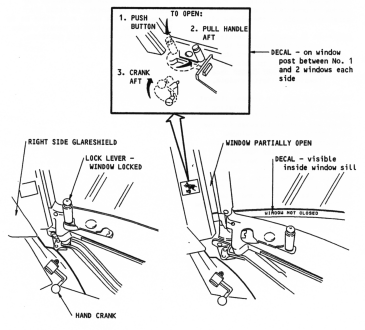
The flight deck number two windows can be opened on the ground or in flight. The flight deck number two windows can be used for emergency evacuation. The window lock lever locks or unlocks the window. Rotating the window Hand Crank opens and closes the window.
Note: It is possible to rotate the window lever forward to the locked position with the window not closed. In this position the WINDOW NOT CLOSED decal remains partially visible
A WINDOW NOT CLOSED placard is visible when the window is open.
To properly lock the window, it must first be fully closed by rotating the Hand Crank, clockwise for the Captains window and counter clockwise for the First Officers. As the window approaches the full closed position, required force on the Hand Crank noticeably increases, but rotation must continue until reaching the limits of travel. When the window is fully closed, rotate the lock lever forward to the locked position and assure the WINDOW NOT CLOSED decal on the window silt is hidden from view. When attempting to close the window, the lock lever must first be in the unlocked position to permit window travel to the full closed position.
The windows can be opened or closed in flight with minor flight deck consequences if the airplane is unpressurised. Because the force required to move the crank increases with airspeed, it is recommended not to exceed VREF 30 + 80 with a window open. It may not be possible to open or close the window at speeds above 250 knots. With the window open, voice, interphone, and radio audio cannot be heard due to high noise levels. Prior communications arrangements with the controlling agency should be established before opening the window. The design provides an area of relatively calm air over the open window. Forward visibility can be maintained by looking out of the open window.
Flight Deck Window Emergency Egress
If the flight deck number two windows must be used for emergency evacuation, exit in accordance with the following illustration [omitted].
CAUTION: Ensure the rope is securely fastened to the airplane.
Passenger Entry/Service Doors
 The passenger entry doors are used to enter and exit the airplane, and also serve as emergency exits. The passenger entry doors are paired along the airplane fuselage. The doors can be opened or closed manually from inside or outside of the airplane.
The passenger entry doors are used to enter and exit the airplane, and also serve as emergency exits. The passenger entry doors are paired along the airplane fuselage. The doors can be opened or closed manually from inside or outside of the airplane.
The entry doors are plug-type doors. During opening, the door first moves inward, then rotates outward and forward. Each door is held in the open position by a gust lock. The gust lock drops into a latch on the upper hinge arm as the door nears its forward limit of travel. Lifting the gust lock lever latches the gust lock lever in the UP position and releases the hinge arm, allowing the door to be closed. A window in each door allows observation outside of the airplane.
An escape slide/raft is contained in a bustle on the lower inboard face of the door. A Wide Angle Viewer is used for observing the outside of the airplane.
![]() The ENTRY DOORS light illuminates and the EICAS advisory message L AFT, L CTR, L FWD, R AFT, R CTR or R FWD ENT DOOR displays when a passenger entry door is not closed and latched and locked. If two doors on the same side of the airplane are not closed and latched and locked, the EICAS advisory message L/R ENTRY DOORS displays.
The ENTRY DOORS light illuminates and the EICAS advisory message L AFT, L CTR, L FWD, R AFT, R CTR or R FWD ENT DOOR displays when a passenger entry door is not closed and latched and locked. If two doors on the same side of the airplane are not closed and latched and locked, the EICAS advisory message L/R ENTRY DOORS displays.
Passenger Entry Door and Slide Operation
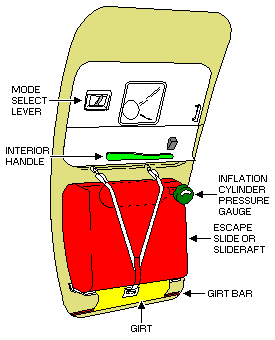 Emergency evacuation slide and pneumatic door opening systems are provided for each passenger entry door. Each door system has enough power to open the door unassisted, even if the airplane is not level because of any landing gear collapse condition. A slide bustle in the lower face of the door contains the evacuation slide or slide raft (illustration shows door with bustle removed).
Emergency evacuation slide and pneumatic door opening systems are provided for each passenger entry door. Each door system has enough power to open the door unassisted, even if the airplane is not level because of any landing gear collapse condition. A slide bustle in the lower face of the door contains the evacuation slide or slide raft (illustration shows door with bustle removed).
For normal operations, the slide must be disarmed before opening the door. Moving the mode select lever to DISARMED causes the slide girt bar to detach from the floor, the SLIDE light to extinguish [and] the mechanical SLIDE ENGAGED warning placard to retract.
When the door is disarmed the spring-loaded DISARMED placard will rotate down into view.
The emergency door opening system is armed when the mode select lever is in the ARMED position. This engages the slide girt bar and arms both the slide and the emergency door opening systems. The SLIDE light above the door illuminates and the slide placard extends out over the door-operating handle. Once armed, moving the interior door-operating handle to the open position unlocks the door and moves it inside to the cocked position. The door can then be pushed out through the door frame. The first outward movement of the door activates the emergency door opening system, which drives the door open, and the slide automatically deploys and inflates.
A manual inflation handle can be pulled if the slide has not automatically inflated.
The emergency door opening system and the slide are automatically disarmed when the door is opened from the outside. If the mode select lever is in the ARMED position and the door is opened using the exterior door handle, the mode select lever automatically moves to DISARMED and the door opens without slide deployment.
The passenger door evacuation slides may are also be configured as rafts.
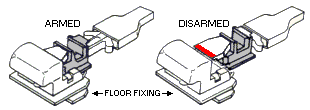 Girt bar engagement can be visually verified by lifting the forward and aft corners of the door sweeper seal. When the red stripe on top of both girt bar sliders are covered by the floor retainers, the girt bar is engaged. If a red stripe is visible the girt bar is not properly engaged, and must be corrected prior to departure.
Girt bar engagement can be visually verified by lifting the forward and aft corners of the door sweeper seal. When the red stripe on top of both girt bar sliders are covered by the floor retainers, the girt bar is engaged. If a red stripe is visible the girt bar is not properly engaged, and must be corrected prior to departure.
Emergency Doors

An emergency door is located aft of the wing on each side of the airplane. The emergency door is only used as an emergency exit. A slide bustle in the lower face of the door contains an evacuation slide. A window in the door allows observation outside of the airplane.
The emergency door is a plug-type door and is hinged on the bottom. Pulling the door-operating handle up lifts the door inward and upward and opens a pressure relief door. The door can then be pushed out through the door frame and the slide automatically deploys and inflates.
A manual inflation handle can be pulled if the slide has not automatically inflated.
![]() The EMER DOORS light illuminates and the EICAS advisory message L/R EMER DOOR displays when an emergency door is not closed and latched and locked. If both doors are not closed and latched and locked, the EICAS advisory message EMER DOORS displays.
The EMER DOORS light illuminates and the EICAS advisory message L/R EMER DOOR displays when an emergency door is not closed and latched and locked. If both doors are not closed and latched and locked, the EICAS advisory message EMER DOORS displays.
The emergency door evacuation slide's are not configured as rafts, however they may be used as auxiliary flotation devices.
Wing Doors (757-300)
Forward and aft wing doors are located over the wing on each side of the airplane. The wing doors are only used as emergency exits. An over wing evacuation ramp and slide assembly is contained in an exterior compartment near the aft edge of each wing. A window in the wing door allows observation outside of the airplane.
The wing door is a plug-type hatch. The emergency PULL handle opens the door. The door can then be removed from the opening. Opening the wing door automatically deploys and inflates the ramp and slide.
A manual inflation handle can be pulled if the ramp and slide has not automatically inflated.
The wing door ramp and slide is automatically disarmed when the door is opened from the outside.
![]() The EMER DOORS light illuminates and the EICAS advisory message L AFT, L FWD, R AFT or R FWD WING DOOR displays when a wing door is not closed and latched and locked. The EMER DOORS light also illuminates and the EICAS advisory message L/R WING SLIDE displays if the door to the ramp slide stowage compartment is not closed and latched and locked. The EICAS advisory message EMER DOORS displays if two or more emergency doors, wing doors or wing slide doors are not closed and latched and locked.
The EMER DOORS light illuminates and the EICAS advisory message L AFT, L FWD, R AFT or R FWD WING DOOR displays when a wing door is not closed and latched and locked. The EMER DOORS light also illuminates and the EICAS advisory message L/R WING SLIDE displays if the door to the ramp slide stowage compartment is not closed and latched and locked. The EICAS advisory message EMER DOORS displays if two or more emergency doors, wing doors or wing slide doors are not closed and latched and locked.
The wing door ramps and slides are not configured as raft and they may not be used as auxiliary flotation devices.
Cargo Doors
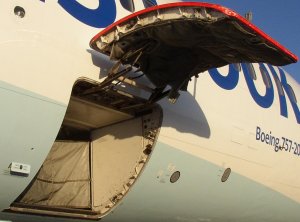 There are two Cargo Doors; one forward and one aft. Both doors are located on the right side of the airplane. The cargo doors open upward and outward.
There are two Cargo Doors; one forward and one aft. Both doors are located on the right side of the airplane. The cargo doors open upward and outward.
Both forward and aft cargo doors are normally operated electrically from an exterior or interior fuselage-mounted control panel located with each door. Forward and aft cargo door locking is accomplished manually. If necessary, the forward and aft cargo doors may be operated manually.
 The CARGO DOORS light illuminates and the EICAS advisory message FWD or AFT CARGO DOOR displays when any cargo door is not closed and latched and locked. The EICAS advisory message CARGO DOORS displays if both cargo doors are not closed and latched and locked.
The CARGO DOORS light illuminates and the EICAS advisory message FWD or AFT CARGO DOOR displays when any cargo door is not closed and latched and locked. The EICAS advisory message CARGO DOORS displays if both cargo doors are not closed and latched and locked.
Access Doors
![]() Access to the forward equipment bay and the electronics bay is provided in the forward lower fuselage. If either door is not closed and locked, the ACCESS DOORS light on the overhead panel illuminates and the EICAS advisory message FWD ACCESS DOOR or E/E ACCESS DOOR displays. If both doors are open, the advisory message ACCESS DOORS appears.
Access to the forward equipment bay and the electronics bay is provided in the forward lower fuselage. If either door is not closed and locked, the ACCESS DOORS light on the overhead panel illuminates and the EICAS advisory message FWD ACCESS DOOR or E/E ACCESS DOOR displays. If both doors are open, the advisory message ACCESS DOORS appears.
Flight Deck Seats
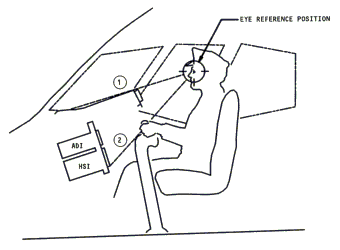
The pilot seats:
- Recline
- Adjust vertically
- Adjust forward and aft
- Adjust for thigh support
- Adjust for the lumbar region of the back
The seats also have:
- Adjustable armrests
- Crotch straps
- Inertial-reel shoulder harnesses with manual locks
- Lap belts
- Adjustable headrests
The seats move outboard during the last four inches of travel. Manual controls provide forward, aft, and vertical adjustment.
Lumbar and thigh pad support can be adjusted using the adjustment hand wheels. Armrest pitch can be adjusted using the control knob under the armrest. The armrests can be stowed vertically for easier seat access.
Adjust the seat to obtain the optimum eye position as shown on the above illustration:
- Adjust the seat to the upright position; sitting up straight; looking straight ahead.
- The control column must be in the neutral position.
- Adjust the seat until:
- the top of the glareshield appears as the edge of a plan and
- the bottom the HSI is visible over the control column
Warning: If there is a crack in the middle pane, replace it immediately. Correct pressurisation of the fuselage is critical. A crack in the window pane causes incorrect fuselage pressurisation.
Note: Middle pane cracks that start from the vent hole and are 0.062 inch or less in length do not need to be replaced.